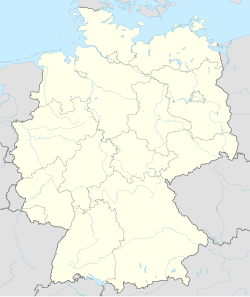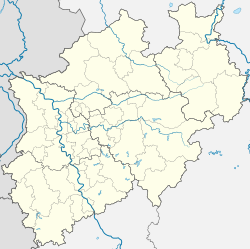Bonn
Bonn (Latin: Bonna) is a city near Cologne. It is in the German state of North Rhine-Westphalia.
Bonn | |
|---|---|
 Langer Eugen, centre of the UN Campus at the River Rhine in Bonn (view from the Post Tower). | |
| Coordinates: 50°44′N 7°6′E / 50.733°N 7.100°E | |
| Country | Germany |
| State | North Rhine-Westphalia |
| Admin. region | Cologne |
| District | Kreisfreie Stadt |
| Founded | 1st century BC |
| Government | |
| • Mayor | Katja Dörner (Alliance 90/The Greens) |
| Area | |
| • Total | 141.22 km2 (54.53 sq mi) |
| Elevation | 60 m (200 ft) |
| Population (2022-12-31)[1] | |
| • Total | 336,465 |
| • Density | 2,400/km2 (6,200/sq mi) |
| Time zone | UTC+01:00 (CET) |
| • Summer (DST) | UTC+02:00 (CEST) |
| Postal codes | 53111–53229 |
| Dialling codes | 0228 |
| Vehicle registration | BN |
| Website | www |

Bonn was founded on an old Roman settlement. In 2021 about 327,000 people lived there.
Following World War II Bonn was in the British occupation zone. In 1949 Bonn was chosen as the capital of West Germany.
Bonn was the choice of Konrad Adenauer, a former Cologne Mayor and the first Chancellor of West Germany after World War II, who came from that area. Frankfurt am Main had most of the needed facilities already, so using Bonn meant spending about 95 Million DM to building new roads and building. However, Frankfurt am Main had been an important city during the war, and choosing Bonn was to symbolise a new start for the new Germany.
Because of its relatively small size for a capital city, Bonn was sometimes jokingly called the Bundesdorf (Federal Village).
Bonn was the capital of West Germany from 1949 until 1990. The Bundestag voted to move to Berlin on 20 June 1991, after a heated debate. The Federal President had already decided to make Schloß Bellevue in Berlin his main official residence. The extra building work needed meant it was 1999 before the government's move was completed.
Main sights
changeBeethoven's birthplace is located at Bonngasse. Next to the market place is the Old Town Hall, built in 1737 in Rococo style, under the rule of Clemens August of Bavaria. It's used for receptions of guests of the town, and as a bureau for the mayor. Close by is the Kurfürstliches Schloss, which was built as a residence of the prince-elector, and nowadays is the main building of the University of Bonn.
The Poppelsdorfer Allee, an alley flanked by chestnut trees, connects the Kurfürstliches Schloss with the Poppelsdorfer Schloss, a palace that was built as a resort to prince-electors in the first half of the 18th century. This axis is interrupted by a railway line and Bonn Central Station, a building erected in 1883/84.
The three highest buildings in the city are the radio mast of WDR in Bonn-Venusberg (180 m), the headquarters of the Deutsche Post called Post Tower (162.5 m) and the former building for the German members of parliament Langer Eugen (114.7 m) which nowadays is the new location of the UN-Campus.
Churches
change- Bonn Minster [1] Archived 2009-02-15 at the Wayback Machine
- Doppelkirche (Double Church) Schwarzrheindorf built in 1151
- Old Cemetery Bonn, one of the best known ones in Germany
Castles and residences
change- Godesburg fortress ruins [2] Archived 2005-05-25 at the Wayback Machine
Modern buildings
change- Bundesviertel (federal quarter) with lots of government structures including
- Post Tower, the tallest building in the state North Rhine-Westphalia, housing the headquarters of the Deutsche Post AG
- Deutsche Telekom headquarters
- T-Mobile headquarters
- Maritim Bonn, 5 star hotel and convention centre
- Schürmann-Bau, headquarters of Deutsche Welle
- Langer Eugen, since 2006 the centre of the United Nations Campus, formerly housing the offices of the members of the German parliament
Museums
change- Museum Mile with
- Kunst- und Ausstellungshalle der Bundesrepublik Deutschland (Art and Exhibition Hall of the Federal Republic of Germany) showing the Guggenheim Collection in 2006-2007 [3] Archived 2009-05-09 at the Wayback Machine
- Kunstmuseum Bonn (Bonn Museum of Modern Art) [4]
- Haus der Geschichte der Bundesrepublik Deutschland (Museum of the History of the Federal Republic of Germany) [5]
- Museum Koenig where the Parlamentarischer Rat first met
- Beethoven House, birthplace of Ludwig van Beethoven [6] Archived 2017-04-12 at the Wayback Machine
- Ägyptisches Museum (Egyptian Museum) [7] Archived 2007-11-24 at the Wayback Machine
- Akademisches Kunstmuseum (Academic Museum of Art) [8] Archived 2008-02-10 at the Wayback Machine
- Arithmeum, research institute for discrete mathematics including a museum [9] Archived 2008-02-18 at the Wayback Machine
- Rheinisches Landesmuseum Bonn (Rhinish Regional Museum Bonn)
Universities
change- The Rheinische Friedrich-Wilhelms-Universität Bonn (University of Bonn) is one of the largest universities in Germany
- Bonn Universities are located mainly in downtown Bonn, but some buildings are spread throughout the city. As such Bonn is known as the city of Universities.
Schools
changeNature
change- Botanischer Garten (Botanical Garden), where Titan arum reached a world record
- Rheinaue (Bonn), a leisure park on the banks of the Rhine
- Rhine promenade and the Alter Zoll (Old Toll Station)
- In the very south of the city on the border to Wachtberg and Rhineland-Palatinate is the extinct volcano Rodderberg
Twin towns
change- Bonn
- United Kingdom Oxford, since 1947
- Israel Tel Aviv-Jaffa, since 1983
- Germany Potsdam, since 1988
- Hungary Budafok, District XII of Budapest since 1991
- Poland Opole, (officially since 1997; contacts were established 1954)
- United Kingdom Belfast, Northern Ireland
- district of Bad Godesberg
- district of Beuel
- district of Hardtberg
References
changeOther websites
change Media related to Bonn at Wikimedia Commons
The dictionary definition of Bonn at Wiktionary
- Official Website Archived 2006-08-30 at the Wayback Machine (in English)
- Official timeline Archived 2006-05-21 at the Wayback Machine (in German)
- Tourist information Archived 2006-04-11 at the Wayback Machine
- "The Museum Mile" Archived 2008-05-16 at the Wayback Machine
- Germany's Museum of Art in Bonn Archived 2009-05-09 at the Wayback Machine




